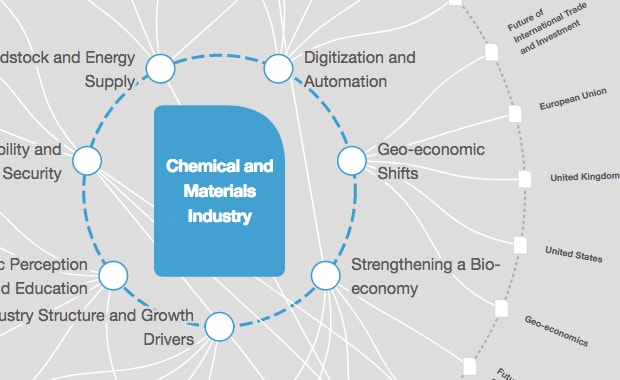How chemistry is part of the solution to climate change – and not just part of the problem

Chemical world … a display of detergents in a department store in Brussels, Belgium. Image: Reuters
- Chemical-based products often have a harmful impact on the environment, including their CO2 emissions toll.
- Green chemistry minimizes the use of hazardous substances when designing products and processes.
- Resulting in more efficient manufacturing processes, green chemistry is also good for business.
There’s little doubt that chemistry has had a profound and positive impact on our lives. Used in everything from detergent and toothpaste, to medicines, plastic, paints and beyond, chemicals play an integral role in society. Unfortunately, using some comes with serious unintended consequences, with harmful compounds damaging both the environment and human health.
While it can pose problems, chemistry is not the enemy. In fact, one branch of chemistry – green chemistry – offers a promising solution. Taking its lead from nature, its approach is to design chemical products and processes in a way that reduces or eliminates the use or generation of hazardous substances, thereby creating better, safer end results and reducing waste. Its application encompasses the entire life cycle of a product, from design and manufacture, through to use and recycling or disposal at the end of its useful life.
Green chemistry has been championed by 2021 Volvo Environment Prize laureate, Professor Paul Anastas, who has deepened our understanding of chemicals as a revolutionary way to improve the environment. He has established game-changing scientific advances such as the 12 principles of green chemistry, used both in industry and in academic research worldwide to help guide chemists with their efforts to reduce the hazardous effects of our products.
Chemicals' emissions problem
According to the International Energy Agency (IEA), direct CO2 emissions from primary chemical production hit 880 million tonnes in 2018. We are all well aware of the impact rising CO2 levels are having on the environment, destabilizing the climate and causing ocean acidification. If we are to address these emissions, we must look to tackle those contributed by the chemical sector.
The chemical industry is also the largest industrial consumer of both oil and gas, using these as the building blocks to create products. This is not only energy-intensive, but it also produces potentially hazardous waste. Green chemistry looks to replace the use of these non-renewable, depleting resources with renewable materials that are less harmful to humans and the environment.

One of the most exciting innovations to emerge is the use of CO2 itself as a feedstock for making products such as building materials, chemicals and fuels. Scientists at the Los Alamos National Laboratory have also developed a process to use CO2 in computer chip preparation, significantly reducing the quantities of chemicals, energy and water required. Turning CO2 into a useful resource rather than just a harmful by-product is a crucial step towards decarbonizing the economy.
Powering green manufacturing to profit
Besides being better for the environment, green chemistry is also well-placed to benefit the bottom line, with less waste and faster, more energy-efficient manufacturing processes. Add to this higher yields and a move away from a reliance on depleting resources like petroleum products – slowing their depletion – and it avoids the hazards and price fluctuations associated with the use of hydrocarbons.
There are examples of green chemistry in most industry sectors, but Volvo Group knows that chemical substances are present in everything from the plastic components, cables, wires and tyres to part of the instrument panels in our vehicles and machines. We want to ensure our use of these is not detrimental to the environment. We have a black list of chemicals that must not be used and a red list of substances that must be declared; any supplier who wants to work with us must adhere to these requirements. And we’re always looking for new technologies to reduce energy consumption, such as switching to a polyurethane paint system that requires baking at significantly lower temperatures than standard paint systems.
Thanks to a growing network of green chemists across the globe, efforts to implement the principles of green chemistry and design and develop safer chemicals and products that are not harmful to humans or the environment are intensifying. But we need to go further and faster, working in partnership with academic institutions and the scientific community if we are to stem the damage being caused to the world’s ecosystems. What’s more, manufacturers need to collaborate with their supply chains to raise awareness of the need to adopt a way of thinking that aligns with green chemistry.
What is a circular economy?
Green chemistry cannot solve all our environmental challenges, but it provides all the qualities of technology innovation that we come to expect in our modern lives but without the chemical pollution – and makes both environmental and business sense.
Don't miss any update on this topic
Create a free account and access your personalized content collection with our latest publications and analyses.
License and Republishing
World Economic Forum articles may be republished in accordance with the Creative Commons Attribution-NonCommercial-NoDerivatives 4.0 International Public License, and in accordance with our Terms of Use.
The views expressed in this article are those of the author alone and not the World Economic Forum.
Stay up to date:
Chemical and Advanced Materials
Related topics:
Forum Stories newsletter
Bringing you weekly curated insights and analysis on the global issues that matter.







